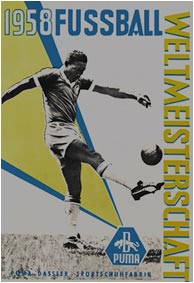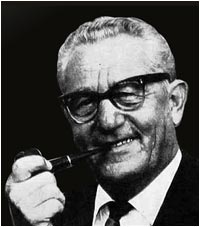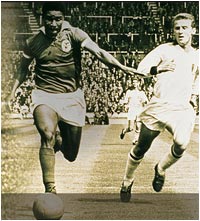1924
-
 Foundation
of Gebrüder Dassler Schuhfabrik, Herzogenaurach, Germany. Foundation
of Gebrüder Dassler Schuhfabrik, Herzogenaurach, Germany.
1936
-
Competing at the Berlin Olympic Games, American hero Jesse Owens wins four Gold
medals wearing Dassler shoes. During the Games, almost every member of the
German Football team wears Dassler shoes. In total, seven Gold and five Bronze
medals as well as two world and three Olympic records are won and set by
athletes wearing Dassler shoes.
1948
-
 PUMA
Schuhfabrik Rudolf Dassler is founded. PUMA
Schuhfabrik Rudolf Dassler is founded.
-
Introduction of the PUMA ATOM, PUMA’s first football shoe.
1949
-
Rudolf Dassler starts developing and producing football boots with screw-in
studs.
1950
-
On-going development of the football boot with screw-in studs in cooperation
with football experts such as Sepp Herberger (German national coach).
-
In the first post-war football match, several members of the West German
national football team wear PUMA boots, including the scorer of West
Germany’s first post-war goal, Herbert Burdenski.
1951
-
First tests of the SUPER ATOM.
1952
-
 Josef
Barthel of Luxembourg wins PUMA’s first Olympic Gold (1500 meters) in
Helsinki, Finland and the US-women relay team wins Gold for the 4x100 meters
– all wearing PUMA. Josef
Barthel of Luxembourg wins PUMA’s first Olympic Gold (1500 meters) in
Helsinki, Finland and the US-women relay team wins Gold for the 4x100 meters
– all wearing PUMA.
-
Production of the SUPER ATOM.
-
At the start of the season, the SUPER ATOM is being distributed to top players
and selected stores.
-
The SUPER ATOM is worn for the first time by top players of the clubs Borussia
Dortmund (10 players), Eintracht Frankfurt (1 player), VfB Stuttgart (9
players) as well as 1. FC Kaiserslautern (7 players). Among others, two players
wearing the SUPER ATOM for the first time are Horst Eckel und Werner Liebrich,
who, due to their excellent performance in the field, advance into the German
national team.
1953
-
Advertisement campaign „Deutschlands
Fußball-Elite“(Germany´s football elite) accompanies the
successful launch of the SUPER ATOM.
-
Development and first tests of the enhanced version BRASIL.
1954
-
 In
Yokohama, West Germany’s Heinz Fütterer sets a new world record in
the 100 metres sporting PUMA shoes. In
Yokohama, West Germany’s Heinz Fütterer sets a new world record in
the 100 metres sporting PUMA shoes.
-
Launch of BRASIL with top football players of the club Hannover 96.
-
In May, during the finals of the German football championships, Hannover 96
wins against 1. FC Kaiserslautern in Hamburg and is crowned the Champion of the
German premier league that season. Eight out of eleven champions wear the PUMA
screw-in stud boots BRASIL.
-
Launch of the advertisement campaign „So war es in Hamburg“
(“That’s what it was like in Hamburg”).
1958
-
Swedish and Brazilian national team football players, competing at the World
Cup in Sweden, wear PUMA shoes sporting PUMA’s signature formstrip for
the first time.
1959
-
The company is transformed into a limited partnership, registered under
PUMASportschuhfabriken Rudolf Dassler KG.
1960
-
 West Germany’s Armin Hary wins the 100 meter sprint at the Olympic Games
in Rome wearing PUMA track shoes.
West Germany’s Armin Hary wins the 100 meter sprint at the Olympic Games
in Rome wearing PUMA track shoes.
PUMA is the first sports shoe manufacturer to use the technologically advanced
vulcanization production technique.
1962
-
Pelé, for the second time in a row, wins a World Cup in PUMA boots, in
Chile.
1964
-
Belgium’s Gaston Roelants (3000 meters steeplechase), Great
Britain’s Mary Rand (long jump) and Ethiopia’s Abebe Bikila
(marathon) win Gold medals wearing PUMA at the Tokyo Olympic Games.
1966
-
At the World Cup in England, legendary PUMA KING football shoes are sported for
the first time by Portuguese superstar Eusebio, top scorer and “Player of
the Tournament”.
1968
-
 Four
PUMA athletes win Gold medals at the Olympic Games in Mexico: Tommie Smith (200
meters), Lee Evans (400 meters/4 x 400 meters), Willie Davenport (110 meters
high hurdles) and Bob Seagren (pole-vault). Four
PUMA athletes win Gold medals at the Olympic Games in Mexico: Tommie Smith (200
meters), Lee Evans (400 meters/4 x 400 meters), Willie Davenport (110 meters
high hurdles) and Bob Seagren (pole-vault).
-
Wearing PUMA track shoes, Jim Hines is the first man to run the 100 meter
sprint in less than 10 seconds.
-
PUMA is the first manufacturer to offer sports shoes with Velcro®
fasteners.
1969
-
Quarterback Joe Namath leads the New York Jets (American football team) to
success in the Super Bowl III, wearing PUMA shoes.
1970
-
Pelé – again “Player of the Tournament” – wears
PUMA KING boots and helps Brazil to win his and his country’s third World
Cup title by beating Italy in the Mexico finals.
|














